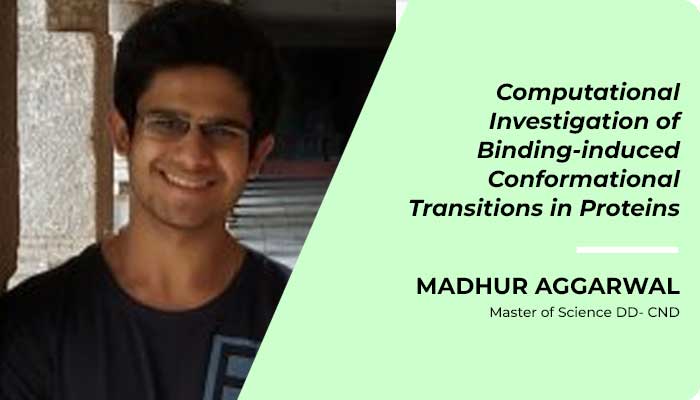Madhur Aggarwal received his Master of Science – Dual Degree in Computational Natural Sciences (CND). His research work was supervised by Dr. Krishnan Marimuthu. Here’s a summary of his research work on Computational Investigation of Binding-induced Conformational Transitions in Proteins: Application of Minimum Energy Path Analysis and Enhanced Sampling Methods:
The conformational dynamics of proteins is essential for biological functions. The characterization of binding-induced changes in protein conformational dynamics is of paramount importance to understand the fundamental processes of life. Molecular modelling and molecular dynamics simulations have emerged as useful computational tools to probe atomistic details of molecular recognition and binding-induced dynamical responses of proteins. The interactions of proteins with DNA and small drug molecules play crucial roles in regulating various cellular processes. The present thesis reports results of investigation of the functional roles of protein conformational dynamics in the following two important biological systems: (a) a DNA repair protein complexed with a mistmatched DNA and (b) an inhibitor drug-bound human c-Src kinase. In the former system, our primary objective is to understand the molecular mechanism of how a specific DNA repair protein (RAD4/XPC) binds to a damaged DNA, recognizes lesions and repair them efficiently using molecular dynamics and enhanced sampling simulations. In the latter system, we have investigated drug-induced conformational transitions in human c-Src kinase to understand its activation mechanism using molecular dynamics simulations and nudged elastic band method. DNA damage caused by ultraviolet (UV) radiation can lead to a range of genetic skin conditions and cancers. The protein Rad4/XPC recognizes and repairs these types of DNA damage with high accuracy to safeguard the integrity of the genome. However, the precise mechanism of how Rad4/XPC recognizes DNA damage in the crowded cellular milieu is not yet fully understood. The first part of this thesis investigates the mechanism, energetics, dynamics, and molecular basis of Rad4/XPC’s recognition with base pair mismatched DNA lesions. In particular, the mechanism of association of RAD4 with the mismatched DNA is investigated using molecular dynamics and umbrella sampling simulations. The Rad4-DNA association free energy surfaces are determined for three Rad4-DNA complexes (CCC/CCC, TTT/TTT, and TAT/TAT) and the sequence-dependent specificity of Rad4 for mismatched DNA is explored. The results reveal that Rad4 exhibits higher specificity for CCC/CCC mismatched DNA compared to the other two mismatches. The key molecular interactions contributing to Rad4- DNA association and specificity are characterized. Protein kinases act as biological switches that toggle between ON (active) and OFF (inactive) states in response to specific cellular signals to regulate various cellular processes including growth, cell proliferation and differentiation. Since protein kinases are implicated in tumorigenesis and malignant cell proliferation, they have become favourable targets for cancer therapy. The second part of the thesis focuses on drug-induced conformational transition of c-Src kinase between active (drug-bound) and inactive (drug-free) states using the minimum energy path analysis and molecular dynamics simulation. The crucial role of hydration of the binding pocket in the association/dissociation of drug from the kinase is explored. The coupling between the entry and exit of the drug, influx of water molecules into vi the binding pocket and critical interactions of key kinase residues near the binding pocket appears to influence the conformational transition between the active and inactive states of the kinase. We believe that the molecular mechanisms elucidated will be useful for rational design of novel therapeutics against cancer and other kinase-related diseases.

